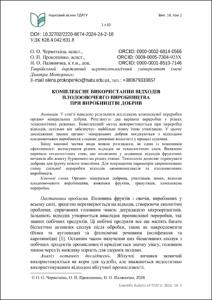Please use this identifier to cite or link to this item:
http://elar.tsatu.edu.ua/handle/123456789/18202| Title: | Комплексне використання відходів плодоовочевго виробництва при виробництві добрив |
| Other Titles: | Complex use of waste from fruit and vegetable production in fertilizer production |
| Authors: | Червоткіна, Олександра Олександрівна Прокопенко, Олена Павлівна Паляничка, Надія Олександрівна Chervotkina, Oleksandra Prokopenko, Olena Palianychka, Nadiia |
| Keywords: | органо-мінеральні добрива;утилізація;жмих;відходи плодоовочевого виробництва;вижимки фруктів;грануляція;комплексна переробка;agro-mineral fertilizers;utilization;pulp;waste of fruit and vegetable production;fruit pomace;granulation;complex processing |
| Issue Date: | 2024 |
| Publisher: | Запоріжжя : ТДАТУ |
| Citation: | Червоткіна О. О., Прокопенко О. П., Паляничка Н. О. Комплексне використання відходів плодоовочевго виробництва при виробництві добрив. Науковий вісник Таврійського державного агротехнологічного університету : електронне наукове фахове видання. Запоріжжя : ТДАТУ, 2024. Вип. 14 т. 2. C. 207-216. |
| Abstract: | UA: У статті наведено результати досліджень комплексної переробки органо- мінеральних добрив. Розглянуто два варіанта переробки у різних технологічних режимах. Комплексний метод використовується при переробці відходів, оскільки він забезпечує- найбільш повну їхню утилізацію. У цьому дослідженні зразки органо- мінеральних добрив поєднуються з відходами плодоовочевих виробництв з оцінки динаміки вологості у процесі сушіння. Зміну масової частки води можна розглядати, як один із показників ефективності застосування різних відходів та технологічних схем. Виявлено переваги технологічних схем, що полягають у додаванні відходів фруктових вичавків або жмиху бурякового на різних етапах. Технологія дозволяє отримувати добрива для ґрунту нового покоління. Для покращення параметрів запропоновано схему спільної переробки відходів свинокомплексів та плодоовочевих виробництв. EN: The article presents the results of research into complex processing of organomineral fertilizers. Two variants of processing in different technological regimes are considered. The complex method is used in waste processing, as it ensures the most complete disposal of waste. In this study, samples of organomineral fertilizers are combined with waste from fruit and vegetable production to assess the dynamics of moisture during the drying process. The change in the mass fraction of water can be considered as one of the indicators of the efficiency of the application of various wastes and technological schemes. The advantages of technological schemes consisting in the addition of waste fruit juices or beet pulp at different stages have been revealed. The technology makes it possible to obtain fertilizers for the soil of a new generation. To improve the parameters, a scheme of joint processing of waste from pig farms and fruit and vegetable production is proposed. Ukraine belongs to the countries with a high level of development of agriculture, the sphere of consumption of various products of industrial and agrarian origin. Every year, more than 1 billion tons of natural substances are involved in economic circulation in Ukraine. These are raw materials and products of various types of industry, in particular, a large share is occupied by agriculture and the production of organic-mineral fertilizers. Therefore, as a result of conducting research on complex processing of organic-mineral fertilizers, two options for processing waste from agricultural production were considered. A comprehensive method of waste processing allows us to ensure their complete disposal. The fruit and vegetable sector produces a large amount of waste, which creates both environmental and economic problems. The authors conducted a study on waste after the processing of carrots, apples, and sugar production. It was also found that the waste processing technology makes it possible to obtain fertilizers for the soil of a new generation. In recent years, there has been an increased demand for organic-mineral fertilizers. Most farmers use dry fertilizers - more than 80% of all fertilizers applied in the world. |
| URI: | http://elar.tsatu.edu.ua/handle/123456789/18202 |
| ISSN: | 2220-8674 |
| DOI: | 10.32782/2220-8674-2024-24-2-18 |
| UDC: | 628.4.042:631.8 |
| Appears in Collections: | кафедра Обладнання переробних і харчових виробництв ім. професора Ф.Ю. Ялпачика |
Files in This Item:
| File | Description | Size | Format | |
|---|---|---|---|---|
| Scientific Bulletin of TDATU_14_2_2024_207-216.pdf | 377.01 kB | Adobe PDF |  View/Open |
Show full item record
CORE Recommender
???jsp.display-item.check???
Items in DSpace are protected by copyright, with all rights reserved, unless otherwise indicated.
